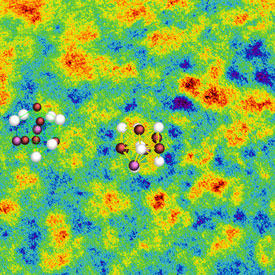

01/29/2018

© 2018 Akihiko Hirata
Using state-of-the-art analytical instruments, AIMR researchers have probed the nanoscale structure of a group of materials known as metallic glasses and discovered the origin of their non-uniformity on a nanometer scale for the first time1.
Metals generally have highly ordered crystalline structures. But under certain conditions, some form disordered, glass-like structures. Known as metallic glasses, these materials have intrigued materials scientists since they were first reported in 1960.
One aspect that has puzzled researchers is that, while metallic glasses have a random structure on a macroscale, nanoscale measurements have shown that their responses to stimuli vary at different sites on a sample. This indicates that metallic glasses are non-uniform on a nanoscale, but attempts to discover the reason for this non-uniformity had failed.
Now, by using scanning transmission electron microscopy and angstrom-beam electron diffraction, Akihiko Hirata of the AIMR at Tohoku University and his co-workers have found that metallic glass consists of two distinct regions on a nanoscale: dense regions, which have the order of a distorted 20-sided polygon (icosahedron), and less-dense regions, which are more disordered but still possess some crystal order (see image).
“It is extremely difficult to determine the structural differences between nanoscale regions using conventional X-ray, neutron or electron-scattering methods,” says Hirata. “By utilizing the angstrom-beam electron diffraction developed by our group, we have been able to detect the local structure order of spatial heterogeneity of metallic glass for the first time.”
Discovering the nanostructure of metallic glasses is a key factor in determining their properties. “The grain size and dislocation density basically determine the strength and hardness of crystalline materials,” says Hirata. “Metallic glasses, however, lack such key structural indicators due to their disordered amorphous structure. We believe that the spatial non-uniformity may play an important role in determining the mechanical and dynamic properties of metallic glasses.”
The finding has significant implications for understanding metallic glasses. “Many intriguing phenomena of glassy materials stem from their complexity,” says Hirata. “In a simplistic model, glassy materials are treated as being completely disordered. But our work has shown that at the nanoscale there are two distinct kinds of disorder in metallic glass. There must be an underlying mechanism for the formation of this disordered system.”
In the future, the team intends to explore the effect of this non-uniformity on the mechanical properties of glass. They will also search to see whether the same non-uniformity exists in other metallic glasses.
This research highlight has been approved by the authors of the original article and all information and data contained within has been provided by said authors.